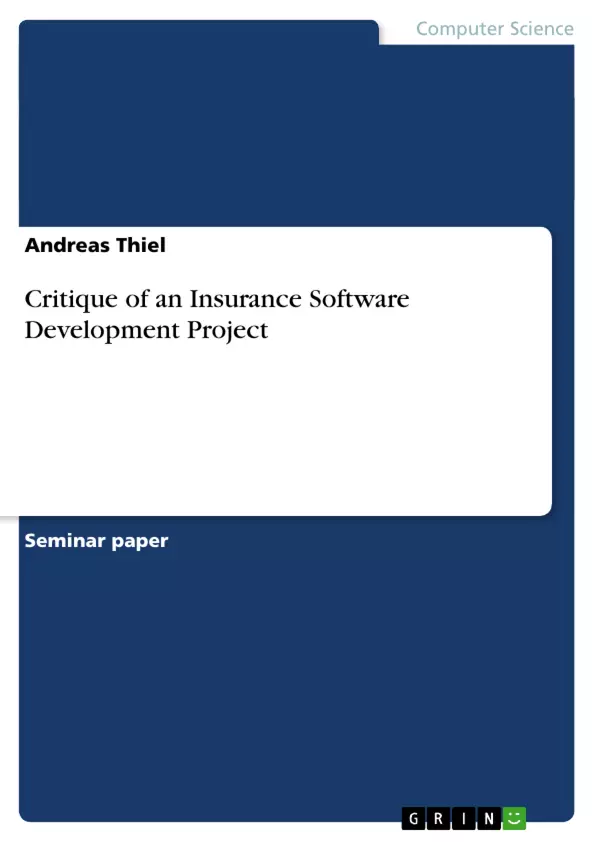In April 1994 the insurance company Giga Safe Corp. started a software
development project. Its goal was to develop a software to automate medical
insurance quotes. It was scheduled as a six-month project and should be ready
by January 1, 1995, when Giga Safe’s new rates were to be released. However,
although the project started with a highly motivated team and high expectations,
it missed all deadlines and was not completed until May 1995.
To sum things up, the project failed mostly because of bad scheduling and
planning, as well as insufficient management control and decreasing team
morale. With a more structured approach to project management and better
planning the project could have been completed in a shorter time.
Inhaltsverzeichnis (Table of Contents)
- Executive Summary
- 1 Introduction
- 2 Project History
- 3 Major Decisions during the Project
- 4 Problems Encountered during the Project
- 5 Project Analysis
- 5.1 Reasons for Failure
- 5.1.1 General Reasons
- 5.1.2 Reasons in the People Management Area
- 5.2 My Approach to Ensure the Project's Success
- 5.2.1 Project Integration, Scope, and Time Management
- 5.2.2 Project Communications and Quality Management
- 5.2.3 Project Risk Management
- 5.2.4 Project Human Resource Management
- 5.1 Reasons for Failure
- 6 Conclusion
- 7 References
Zielsetzung und Themenschwerpunkte (Objectives and Key Themes)
This report analyzes a failed software development project, focusing on the reasons behind its failure and exploring potential solutions to prevent similar situations. The report aims to provide a deep understanding of the challenges encountered in managing IT projects and to offer a practical approach to ensure success in future endeavors.
- Project Management Challenges
- Impact of Poor Planning and Scheduling
- Importance of Team Dynamics and Communication
- Effective Risk Management Strategies
- Project Success Factors
Zusammenfassung der Kapitel (Chapter Summaries)
- Executive Summary: This section provides a concise overview of the failed software development project, outlining its objectives, timeline, and primary reasons for its failure. The project missed all deadlines and was completed much later than anticipated.
- Introduction: This chapter establishes the context of the project and emphasizes the high failure rate of IT projects. It introduces the case study used in the report and outlines its objectives, aiming to identify reasons for the project's failure and provide potential solutions.
- Project History: This chapter details the origin of the project, including the initial proposal, funding, and deadline setting. It explores the project manager's decisions and the challenges faced in assembling the team and developing a schedule.
- Major Decisions during the Project: This chapter examines key decisions made during the project, including the choice of programming language, hiring practices, and the approach to development. It explores the impact of these decisions on the project's progress.
- Problems Encountered during the Project: This chapter explores the various challenges and setbacks encountered during the development process, including scheduling conflicts, changes in requirements, and communication issues.
- Project Analysis (5.1 Reasons for Failure): This section analyzes the primary reasons for the project's failure, focusing on both general factors and those related to people management.
- Project Analysis (5.2 My Approach to Ensure the Project's Success): This section explores potential solutions to prevent future failures, emphasizing the importance of effective project management, communication, risk management, and human resource management.
Schlüsselwörter (Keywords)
This report focuses on the key concepts of project management, software development, IT project failure, risk management, team dynamics, communication, and project success factors. The case study emphasizes the importance of planning, scheduling, resource management, and effective communication in achieving project success.
- Arbeit zitieren
- Andreas Thiel (Autor:in), 2001, Critique of an Insurance Software Development Project, München, GRIN Verlag, https://www.grin.com/document/18248



